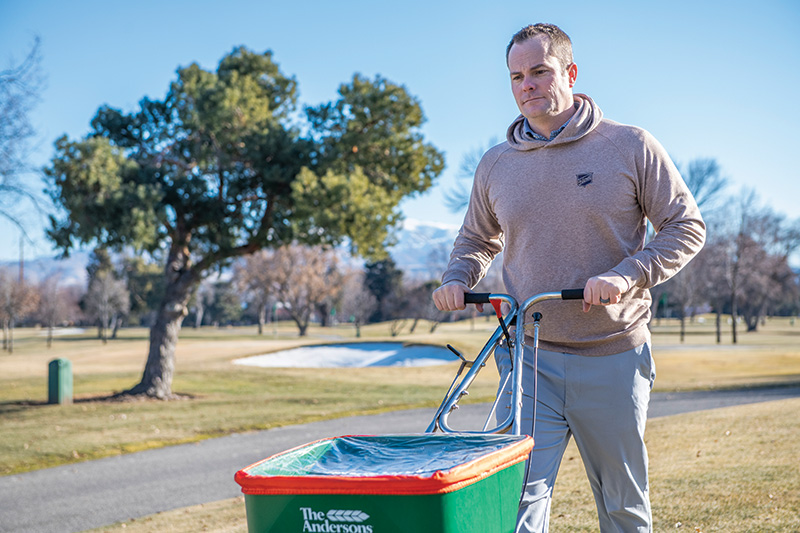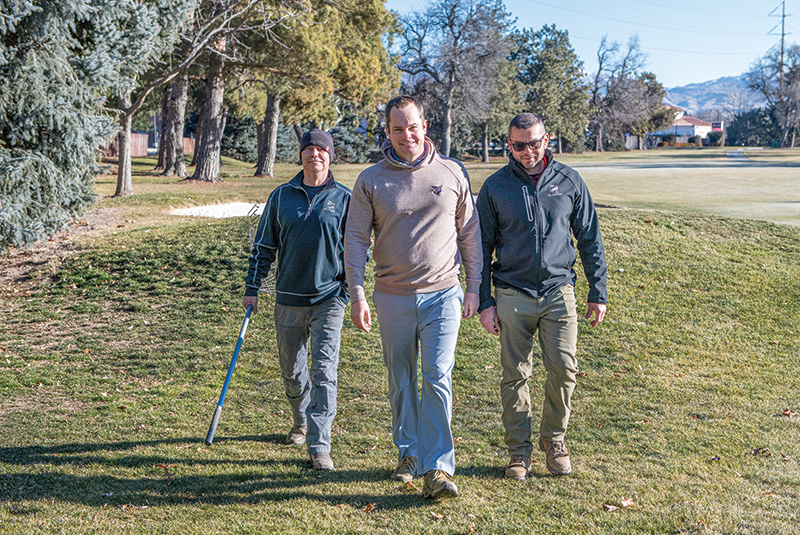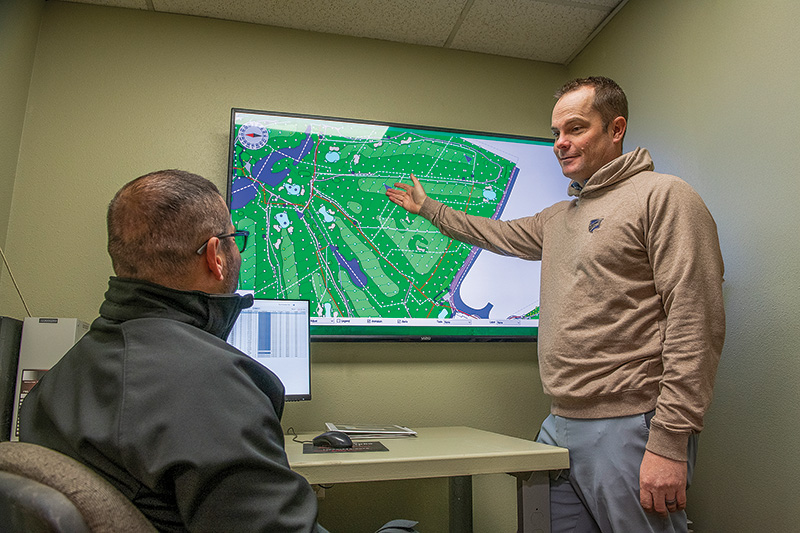
Matt Gourlay, CGCS, MG, AGS, is the winner of the 2025 President’s Award for Environmental Stewardship. He is the superintendent at Hillcrest Country Club in Boise, Idaho, where he relocated in 2023 after 16 years at Colbert Hills Golf Course in Manhattan, Kan. Photos by Joshua Roper
It’s little wonder that Matt Gourlay, CGCS, MG, AGS, went into the profession he did. Few can claim a family heritage in golf that goes as far back as Gourlay’s.
“My family lineage with golf goes back a long way. In the 1800s, the world’s foremost experts in golf balls — the featherie golf balls — were Gourlays. If you wanted to play the best golf ball then, you played a Gourlay featherie golf ball,” says Gourlay, referring to the balls made by stuffing a leather sack with goose feathers. “So my family was synonymous with golf balls until the gutta-percha (tree resin) balls came around, and we fell by the wayside. So I guess we could have been playing with Gourlays, but instead we’re playing with Callaways and Titleists.”
More recently, Gourlay — winner of the 2025 President’s Award for Environmental Stewardship — is the third generation in a line of golf course superintendents. And his mom owned her own soil testing company, testing 2,000-plus golf courses’ soil during her career.
“I always remember growing up, being at the kitchen table when my parents would have friends over, and they would always talk golf or talk turf. So, yeah, I can’t think of any profession that I might do besides being a golf course superintendent,” Gourlay says.
“At one point, I thought I wanted to be a golf pro. But in high school, that quickly changed once I realized my golf game is nowhere near the level necessary to be a golf professional by any means,” says Gourlay, who’s a still respectable 9 handicap now, having been as low as a 3.
Instead, Gourlay followed his dad and his grandfather before him into golf course management.
“I always traveled to the golf course with my dad, and I just loved those days. I remember fondly when we lived in Ottawa (Canada), I sat on a briefcase in the front seat to go to the golf course with him,” says Gourlay. “Then my father had the opportunity to be a GM/grow-in superintendent there at Colbert Hills Golf Course (in Manhattan, Kan.), and we followed him.”
The move to the U.S. came in 1999, when Gourlay was in high school. During that time, he worked at Colbert Hills in the pro shop, in food and beverage and as a cart kid. “There were a lot of different jobs that I had until my senior year, when I switched roles and moved down to the turf care center as a seasonal team member,” Gourlay says.
“I fell in love with working on the maintenance side of things and decided to go to college for it there at K-State.”
Before finishing his degree in 2008, Gourlay was an assistant golf course superintendent at Colbert Hills under Kenny Rogers while his dad was still GM. In 2007, Rogers left, leaving an opening for golf course superintendent.
“I applied for the job, and they accepted me even though I didn’t have a degree yet — I had one year left in school. I was very fortunate that Jim Colbert — whom the course is named after and one of the designers and a former PGA Tour player — had faith in my ability at the time. They had always hired from within,” he said.
For 16 years, Gourlay — a 22-year association member — was superintendent there before leaving in December 2023 to take the superintendent job at Hillcrest Country Club in Boise, Idaho.

Gourlay (center) with assistants Robert Gasper (left) and Ernesto Gamez.
President’s Award winner
At the 2025 GCSAA Conference and Trade Show in San Diego, Gourlay collected his President’s Award for Environmental Stewardship. The award was established in 1991 to recognize an exceptional environmental contribution to the game of golf, a contribution that further exemplifies the golf course superintendent’s image as a steward of the land.
“During his career, Matt has practiced sustainable golf course management that showcases golf course superintendents’ dedication to protect the environment,” said GCSAA Immediate Past President Jeff L. White, CGCS, who presented Gourlay with the award in February. “He not only uses best management practices and has a commitment to sustainability but has spent his career educating others on how to implement environmental BMPs.”
The President’s Award is far from the first GCSAA accolade given to Gourlay. He previously won multiple GCSAA/Golf Digest Environmental Leaders in Golf Awards. Those include winning the 2018 Innovative Conservation Award, 2019 Natural Resource Conservation Award and 2023 Healthy Land Stewardship Award. He earned runner-up honors for the 2020 and 2022 Communications and Outreach awards and 2021 Healthy Land Stewardship Award.
“I’m honored, and shocked,” Gourlay said. “I didn’t think I’d done enough, in all honesty, to win the President’s Award. At the end of the day, I’m just trying to do what’s best for the golf course with the resources provided. We’re just trying to make the membership’s money go as far as it can.”
“Environmental stewardship hasn’t been something I’ve been specifically focused on. I’ve always been focused on the ROI, the business aspect of everything. So, the environmentalism just plays a part in that for me.”
Gourlay said among his priorities is creating firmer, faster conditions to maximize playability.
“How do you create firmer, faster? You do that with less inputs — less fertility, less water. If everything is less, and the grass is growing less, then we can mow it less often. If we mow less, there’s less manhours to maintain the course. There’s less wear and tear on the equipment,” Gourlay said. “The list goes on and on of the things we can accomplish just with a reduction of what we put on the golf course. But that, in turn, is environmentally friendly.”
Gourlay’s approach to greenkeeping
A big part of Gourlay’s approach to greenkeeping is following Minimum Levels for Sustainable Nutrition guidelines, a relatively new way of managing soil nutrient levels that can decrease fertilizer inputs and costs while still maintaining desired turf quality and playability levels.
But MLSN wasn’t what he was taught in school.
“When I was in college and learning soils, BCSR was taught — or Base Cation Saturation Ratio. It was a way to balance the soils to have the best turf quality,” Gourlay says.
As he understood it, BCSR was originally intended for agriculture, such as corn yields.
“You want as many bushels of corn per acre as possible,” Gourlay says. “Well, you probably don’t want that on a golf course, from a golfer’s perspective. I’m a single-digit handicapper myself — I don’t want fairways to grow out of control or greens growing so fast that by the end of the day they’re running an 8, whereas in the morning they were a 10.”
Thanks to pursuing continuing education, Gourlay came across MLSN. The approach sets a minimum level of nutrition that turf needs before there’s a visual decline in health.
“By following these MLSNs, we can completely rethink and retool the way we plan fertility on the golf course. If we know the bare minimum for fertility, we can then tailor our approach to have the bare minimum of nutrients and still provide unbelievable conditions,” Gourlay says.
“And if we decrease the amount of nutrients out there, we’re then going to decrease the cost associated with maintaining a golf course. We can also increase the time frame between mowings because it’s not growing as fast and thick. That decreases fuel consumption over the year. You’re going to increase the longevity of the machines. The way I looked at it, it was a better return on investment for the club I was representing.”

A big part of Gourlay’s approach to greenkeeping is following Minimum Levels for Sustainable Nutrition guidelines, a relatively new way of managing soil nutrient levels that can decrease fertilizer inputs and costs while still maintaining desired turf quality and playability levels.
Continuing education and experimentation
If MLSN is environmentally beneficial, reduces cost of inputs and saves money in terms of labor and overhead, why is it not the standard approach to greenkeeping?
“I think it is more standardized now, but it’s just 10 to 14 years old, compared to BCSR, which was out before the 1980s. So continuing education goes a long way,” Gourlay says. “Had I not done continuing education — by going to GCSAA’s conferences or just being a voracious reader — I would probably still be on that BCSR track for soil tests.”
Gourlay has also experimented with reducing other inputs, such as nitrogen, that aren’t part of the BCSR or MLSN soil tests.
“I’ve played around a lot with trying to see just visually how little amount of nitrogen we could apply compared to what was recommended or learned from university,” Gourlay says. “One of the years I was at Colbert Hills, we didn’t apply any nitrogen for a full 12 months. That really changed the way the golf course played and the inputs used on the golf course. For instance, we only mowed greens 54 times that year because we decreased the amount of fertility out there, nitrogen in particular.”
He said experiments like that have led to using less nitrogen over time.
“When I first got into the business in the early 2000s, we were applying 3 to 6 pounds of nitrogen per 1,000 square feet on our greens. My last five years, I had averaged less than a pound. And you’re decreasing cost along with it,” he said.
Gourlay’s dedication to continued learning has resulted in certifications from three golf course management associations around the world: Certified Golf Course Superintendent from GCSAA in 2011, Master Greenkeeper (MG) from the British and International Golf Greenkeeping Association in 2019 and Accredited Golf Course Superintendent (AGS) from the Canadian GSA in 2022. Gourlay said next he plans to pursue Master Superintendent, the Canadian GSA’s highest distinction.
“I’m always trying to push myself to be a better golf course superintendent. Those accreditations show that I’m continuing my education even though I graduated in 2008,” he said.
His dad, David Gourlay, CGCS, who is now retired, said his son’s many credentials haven’t gone to his head.
“When you have pretty high credentials, people can have this image of you, you know,” David said. “But Matt doesn’t have that high image of himself. He’s a very caring, helping individual. He loves to help anybody, whether it’s golf course superintendents or somebody down on their luck outside a restaurant. It’s very common — he’ll go in and buy them food and give it to them. That’s the kind of person he is, very kind, very giving.”

Those who have worked with Gourlay say he gives freely of his time and builds up those around him.
Building others up
Indeed, to those who have worked with him, Gourlay gives freely of his time and builds those around him up, says Curtis Schriever, Class A superintendent at Wichita Country Club who worked for Gourlay for four years at Colbert Hills.
“Probably the most important thing I’ve learned from Matt is just being open to the people you work with and that trying to make everyone better around you is a vital key to success,” says Schriever, a 16-year member of GCSAA. “I remember Matt being the type of person that was willing to help all of us at the same time. He was always a guy that wanted to pick everybody up around him. He’s very generous with his time.”
Shane Rengstorf — an assistant under Gourlay for nine years before taking over as superintendent at Colbert Hills after Gourlay left for Boise — agrees with Schriever’s take.
“Matt did a really good job of making sure everybody enjoyed coming to work. He encouraged open conversation if people had an idea or a concern,” said Rengstorf, Class A superintendent and 15-year GCSAA member. “I don’t know that anybody felt like Matt was their boss and they had to fall in line — it was a turf team. Our shirts say ‘Turf team,’ and it was a team atmosphere with everybody driving in the same direction. It was really easy to keep everybody engaged when they came into work.”
Rengstorf said Gourlay even made his approach to environmental conservation fun.
“It almost seemed like a game or a challenge that became kind of fun — like, how far can we push this Minimum Levels of Sustainable Nutrition?” said Rengstorf. “How can we do more with less, or how can we make the most of our resources and not just do things because that’s the way everybody else is doing it. Don’t just do this cultural practice or that input because that’s what the calendar says. We need to be doing things because that’s what the golf course is telling us it needs. That changed my golf course management style and for the better. I think that’s the way everybody should be thinking about things.”
Data, moisture management and aerification
Gourlay said his most recent approach to environmental stewardship has been implementing sensor technology to help with moisture conservation and management, which he did first at Colbert Hills and now at Hillcrest. Called turfRad from maker TerraRad, two sensors are attached to each fairway mower to measure the volumetric water content to a 2-inch soil depth.
“We’re mowing fairways three times a week, so I receive the data three times a week, showing me how much moisture is in the fairways,” he says, “as opposed to a visual cue or having to go out there and manually check 25 acres of fairways with a handheld sensor.”
With that much data on how much moisture is in each fairway, Gourlay can closely tailor how much irrigation each receives. “We know what moisture percent shows us a visual wilt, so we will push the turfgrass to this visual wilt for certain tournaments,” he says.
In August, Hillcrest hosts the Albertson’s Boise Open on the Korn Ferry Tour. “For that tournament, we will bring that moisture level down to like 9%, which is our cue to get moisture out there,” Gourlay says. “That gives us really firm fairways at 9%. And it allows us to save resources, either in time hand-watering or just the water alone. By having these sensors, we can know exactly what the moisture is out there and tailor watering to the plants’ needs.”
Similarly, data drives Gourlay’s decision whether to aerify.
“I’m not opposed to aerification whatsoever. Here at Hillcrest, looking at the data that we have, our thatch or organic matter in our greens are considered excessive compared to a well-drained USGA green. So, we did a lot of topdressings and aerification this year. We were able to decrease the organic matter in the top inch by 10% in a one-year span. At Hillcrest, we probably have five years to go to get it down to the threshold that we’re trying to work toward,” he says.
“I was very fortunate at Colbert Hills Golf Course that we didn’t have to pull a core, and very seldom did we solid-tine the greens. We had our standard of operation of percent organic matter or percent thatch in the greens that we wanted to maintain. By topdressing and limiting how fast the plant grows, we didn’t have to aerify the greens.”
“I’m a data junky,” Gourlay says. “If the data suggests we should aerify, we will aerify. If we can get away from aerification and the data suggests we don’t need to aerify, we’re not going to waste resources just to say we aerified. We just want to provide a great golf course for our members as much as possible as many days as possible.”
Phil Cauthon (pcauthon@gcsaa.org) is GCM’s managing editor.